|
GORDON SMYTH AND ERIC CRAIG – "TWO
FRIENDS AT WAR" In the mid 1990’s
the History Department at FSL was given an old rusted
tin box that had been retrieved from a skip. It contained
38 photographs and a series of over ninety letters and
post cards dated between the 23 September 1915 and the
11 August 1917 and addressed to Mrs. M.F.D. Smyth 111
University Street, Belfast. Eleven of the letters are
reproduced below.
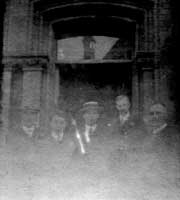 |
111 Universtity
Street.
A faded sepia image recognisable from the
number above the door as 111 Universtity Street,
home of the Smyth Family. The house, converted
into offices, still stands today. |
|
Gordon Smyth.
A young officer in the Royal Irish Rifles
– is this Gordon Smyth? There is a striking
resemblance to the young man standing second
left outside the door of 111 University Street.
|
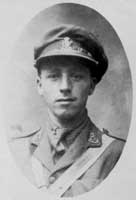 |
|
They were, for the most part, correspondence Mrs.
Smyth had received from her sons John and Gordon. The
earliest, from John who had been serving on the western
front but was invalided back to England, were written
mainly from hospital in Norwich. The majority though
were from Gordon who was serving as a Second Lieutenant
with 13 RIR. In addition, six (included here as numbers
1,2,3,5,6 and 7), were from his close friend Eric Craig.
He had been a former pupil of Foyle College, and was
a medical student at QUB when the war broke out. It
was there that he joined the OTC at the start of the
war, receiving his commission in December 1915 before
leaving for France on the 18 July 1916. After two more
weeks training in Le Havre he was finally posted to
10 RIR sometime around the 6 August. The letters that
he wrote to Mrs. Smyth described his progress from home
to the front but also clearly reveal the strength of
his friendship for Gordon which led him to request a
transfer to his friend’s battalion. The two managed
to meet up on the 22 and 23 August and on the 5 September
Gordon wrote to his mother saying that they hoped to
meet again the following day. It was never to happen.
Eric Craig was already dead, “killed instantaneously”,
according to his friend, “by a German trench mortar”
in Belgium some time between the 28 and 30 August 1916.
It was barely 3 weeks since his departure from Le Havre.
He was only 20 or 21 years of age.
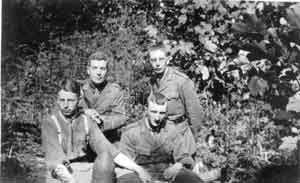 |
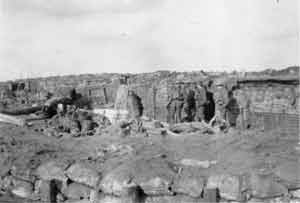 |
Gordon Smyth and
friends.
Away from the fighting. Again is this Gordon Smyth
sitting front left beside the unexploded shell? |
|
|
Breastworks.
A small group of soldiers pose for a photograph
behind the cover of a sandbag breastwork. “Fortifications”
such as these would be used where poor drainage
made digging trenches impractical. |
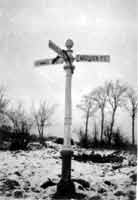 |
The signpost.
Close to St. Quentin Cabaret Military Cemetery.
Was this taken by Gordon Smyth when he visited his
friend’s grave? |
Eric Craig was buried in St. Quentin Cabaret Military
Cemetery, Ploegsteert, Belgium plot 1, row D, grave
19. The cemetery, which derived its name from an “inn”
(used at times as battalion HQ) that stood close by,
is on the south side of the road from Neuve Eglise to
Messines. Writing to his mother on the 12 September,
(letter 11) Gordon spoke about his friend’s death
and how he hoped to visit his grave once he returned
to the area from Divisional Training School behind the
lines. He almost certainly did so. One of the photographs,
which were found along with the collection of letters,
shows the road sign at the junction where the Neuve
Eglise to Messines road branches off to Kemmel. It is
only a few yards from the path that leads to St. Quentin
Cabaret Cemetery.
The Craig family were notified of Eric’s death
on the 4 September. He was the fourth son of Dr. James
and Tillie S. Craig of 2 Carlisle Terrace, Londonderry.
Two of his brothers Lieutenants F.W. and Alexander Craig
also served in the army, both in the RAMC and both appear
to have survived the war. A third brother, M.N. Craig,
writing to Mrs. Smyth (letter 9) described how his Father
has just opened a letter that Eric had left with him
the day he departed for France. It was to be read if
anything should happen him. In it he said, “If
my Chum Gordon should survive me always treat him in
the best possible manner because he is the best chap
I ever met”.
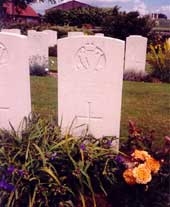 |
Eric
Craig’s grave in St. Quentin Cabaret Military
Cemetery |
|
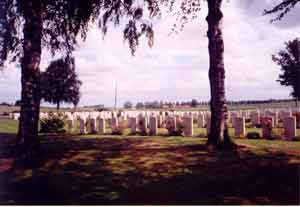 |
| |
St.
Quentin Cabaret Military Cemetery. The front line
where Eric Craig died in just beyond the trees in
the background. |
Gordon Smyth, did survive his friend but hardly by
a year. He was killed in action at Langemarck in Belgium
on the 16 August 1917 aged 21. He has no known grave
but his death is commemorated on the Tyne Cot Memorial,
at Ypres as well as on the war memorial in Fitzroy Presbyterian
church in University Street, Belfast.
We know little of Gordon Smyth other than the impression
we get of him from his letters. That impression is of
a caring son constantly trying to shield an anxious
mother from the reality of his life at the front. He
wrote to her regularly usually about mundane things
such as the weather, letters or parcels he had received,
people he had met or just family gossip. Only once in
June 1917 following the successful attack on the Messines
Ridge is there any reference to the fighting and even
then in the vaguest of fashions. “What do you
think of the latest push?” he wrote on the 15
June. “I think that it is the finest piece of
work that has been done yet”.
More frequently he referred to occasions when he was
out of the line and living in relative comfort. The
principal intention of all this was simply to let her
know that he was alive and well. Her concern at not
hearing from him is evident from a letter he wrote to
her on the 11 August 1917. “I can't understand
how it is that you hadn't heard from me for 8 days.
I wrote every day to you except two days and the only
thing that can be wrong is the postal system”.
Ironically this was the last surviving letter that Gordon
Smyth wrote to his mother. We can only imagine the anguish
at 111 University Street when the news that his mother
most clearly dreaded finally arrived.
 |
 |
 |
 |
 |
 |
 |
 |
 |
 |
 |
| letter 1 |
letter 2 |
letter 3 |
letter 4 |
letter 5 |
letter 6 |
letter 7 |
letter 8 |
letter 9 |
letter 10 |
letter 11 |
 |
 |
 |
 |
 |
 |
 |
 |
 |
 |
 |
|